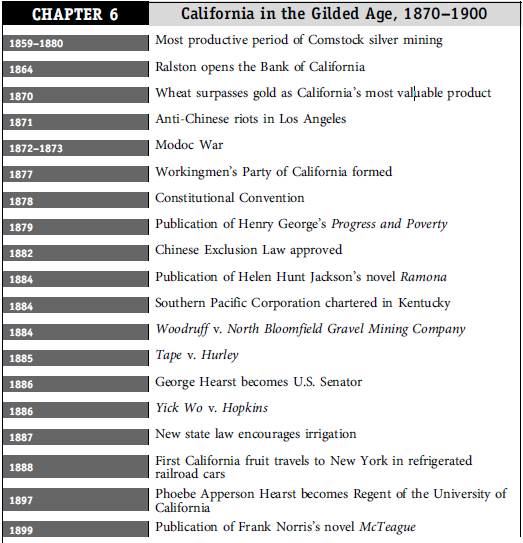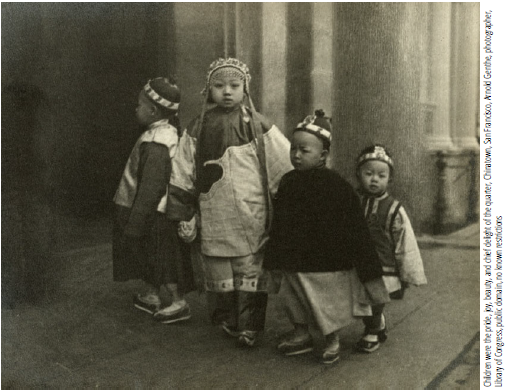6: California in the Gilded Age, 1870–1900
- Page ID
- 126968
Main Topics
- The Economic Transformation of California and the West
- New Social Patterns
- Politics
- Cultural Expression
- Summary
Born in China in 1857, the young orphan took the name Mary McGladery when she lived in the orphanage run by the San Francisco Ladies’ Protection and Relief Society. There, Mary learned English, other school subjects, how to play the piano, and how to be a proper middle-class lady. In 1875, she married Jeu Dip. Born in China in 1852, he came to San Francisco in 1869, learned English, lived mostly outside Chinatown, operated a successful business as a drayman and bondsman, and Americanized his name to Joseph Tape.
The Tapes moved to a house outside Chinatown where their first child, Mamie, was born in 1876. Three more children followed. In 1884, the Tapes tried to enroll Mamie in the school nearest their home, but the San Francisco school board had long denied admission to children of Chinese descent. The Tapes filed a lawsuit to permit Mamie to attend school, and the

court ruled in their favor, as did the state supreme court. However, the San Francisco school superintendent persuaded the legislature to amend state law to permit separate schools for children of Chinese descent. Mamie was again denied admission to her neighborhood school. In turning to the courts, the Tapes were among the significant numbers of Chinese Americans who sought judicial redress when local or state laws violated their legal and constitutional rights, and who helped thereby to break down racial segregation and discrimination.
In a letter published in the newspaper, Mary Tape angrily accused the school board of “Race prejudice” and asserted that Mamie “is more of an American than a good many of you.” Mamie and her brother were the first to enroll at the new Chinese school. Later they moved near Chinatown, where Mamie and her siblings learned Cantonese and other Chinese cultural patterns. In 1895, the Tapes moved to Berkeley, where the younger children could attend the regular public schools, including high school. While still in San Francisco, Mary had become an award-winning and technologically innovative amateur photographer. In Berkeley, Joseph’s businesses continued to prosper, and the Tapes invested in real estate and eventually owned two ranches, where Joseph enjoyed hunting.
Mary and Joseph Tape provide examples of those whom historians of immigration have called “rapid assimilators”— those who quickly learn English and adopt many aspects of the majority lifestyle. Joseph’s successful business enterprises permitted them to live in middle-class, white neighborhoods. Mae Ngai, a historian who has researched the Tape family, describes them as “highly unusual” among the immigrants of their time, but as “archetypical members of the first Chinese American middle class.”
Mamie Tape grew up during what historians call the “Gilded Age,” the years roughly from 1870 to 1900. A period

Children, in the wake of the Chinese Exclusion act, were all too rare and thus highly valued in California's Chinese enclaves. Like Mamie Tape, they confronted discrimination in public education.
of rapid industrialization and urbanization, large-scale immigration, and swift economic development in the West, it was an age of great fortunes and urban poverty, of powerful new technology and rampant child labor. The Gilded Age was, in fact, the title of the first novel by one-time Californian Mark Twain, coauthored with his Connecticut neighbor, Charles Dudley Warner. In it, they satirized the materialism and corruption of their day. Although most histories of the Gilded Age focus on the industries, entrepreneurs, cities, immigrants, and workers of the East and Midwest, California shared in all these experiences, although sometimes with unique variations. And Californians were often at the forefront during this era of rapid and far-reaching change.
Questions to Consider
- Why were railroads and water so important to the economic development of California during this time?
- What made San Francisco the metropolis of the West?
- How was education transformed during this period?
- In what ways did gender roles change during these years?
- How would you compare the experiences of California Indians, Latinos, and immigrants during the late 19th century?
- What was the significance of third parties in California politics during the 1870s and 1890s?
- What were the similarities and differences between the constitutional conventions of 1850 and 1878?
- In what ways did writers and artists draw on California as inspiration for their work?


